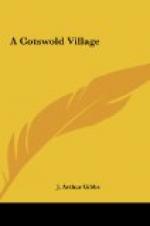(1) March Brown. (2) Olive Dun. (3) Blue Dun. (4) May-fly. (5) Alder. (6) Palmer.
“Wykeham’s Fancy” and the “Grey Quill Gnat” are the only other flies that need be mentioned. The former has a great reputation on the river, but we ourselves have used it but little.
The food on the Coln is most abundant, and to this must be attributed the extraordinary size of the fish as compared with the depth and bulk of water. That one hundred and fifty brace of trout, averaging a pound in weight, are taken with rod and line each year on a stretch of water two miles in length, and varying in depth from two to three feet, with a few deep holes, the width of the water being not more than thirty feet for the most part, is sufficient proof that there is abundance of food in the river.
Where the water is shallow we have found great advantage accrue by putting in large stones and fir poles, to form ripples and also homes for the fish. By this means shallow reaches can be made to hold good fish, and the eddies and ripples make them easy to catch. The stones add to the picturesqueness of the stream, for they soon become coated with moss, and give the idea in some places of a rocky Scotch burn. A pleasant variety of fishing is thus obtained; for at one time you are throwing a dry fly on to the still and unruffled surface of the broader reaches, and a hundred yards lower down you may have to use a wet fly in the narrower and quicker parts, where the stones cause the water to “boil up” in all directions, and the eddies give a chance to those who are uninitiated into the mysteries of dry-fly angling.
The large fish prefer sluggish water, but in these artificial ripples fish may be caught on days on which the stream would be unfishable under ordinary circumstances. It would be invidious to make comparisons between the Coln and the Hampshire rivers—the Itchen and the Test,—these are larger rivers, with larger fish, and they require a better fisherman than those stretches of the Coin that we are dealing with, although the lower reaches of the latter stream are difficult enough for most people.
Otters used to be considered scarce on the River Coln, but two have lately been trapped in the parish of Bibury. With pike and coarse fish we are not troubled on the upper reaches, though lower down they exist in certain quantities. Of poachers I trust I may say the same. Rumour has sometimes whispered of nets kept in Bibury and elsewhere, and of midnight raids on the neighbouring preserves; but though I have walked down the bank on many a summer night, I have never once come upon anything suspicious, not even a night-line. The Gloucestershire native is an honest man. He may think, perhaps, that he has nothing to learn and cannot go wrong, but burglaries are practically unknown, and poaching is not commonly practised.




